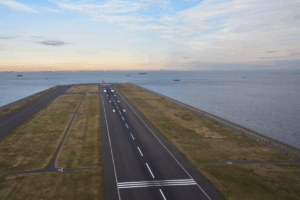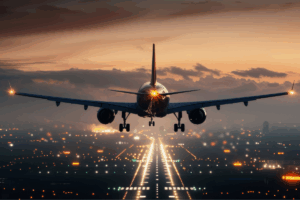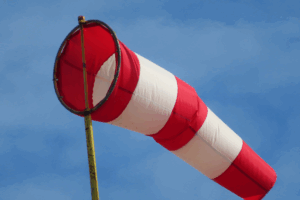Lorsque les aéroports commerciaux ont commencé à fonctionner au début des années 1900, les systèmes d'éclairage des pistes consistaient souvent en des fusées éclairantes au kérosène, des feux de balisage et des projecteurs pour marquer la zone d'atterrissage. À l'époque, les exploitants d'aéroports utilisaient tout ce qui leur tombait sous la main pour assurer le décollage et l'atterrissage sûrs et efficaces des avions.
Aujourd'hui, dans les aéroports modernes, les technologies de pointe sont devenues indispensables dans les systèmes de balisage des pistes. L'indicateur de trajectoire d'approche de précision (PAPI) est un exemple clé d'innovation sur laquelle les pilotes s'appuient pendant l'approche.
Ces appareils sont si efficaces pour améliorer la sécurité des pistes d'aéroport que la Federal Aviation Administration (FAA) et l'Organisation de l'aviation civile internationale (OACI) ont toutes deux rendu obligatoire l'utilisation des systèmes PAPI dans la plupart des aéroports commerciaux.
Dans le blog de ce mois-ci, nous découvrons ce que font les unités PAPI, comment elles fonctionnent et pourquoi votre aéroport doit disposer d'unités PAPI opérationnelles.
Fonctionnement des systèmes d'indicateurs de trajectoire d'approche de précision
Une unité PAPI est une série de luminaires installés à côté de la piste. Les grands aéroports utilisent généralement quatre têtes d'éclairage alignées sur une seule rangée, tandis que certains petits aérodromes n'utilisent que deux têtes d'éclairage.
Chaque appareil PAPI émet un faisceau divisé en deux zones de couleur : le blanc en haut et le rouge en bas. Les pilotes voient un mélange de ces couleurs qui indique leur angle d'approche actuel :
- Un plus grand nombre de feux blancs que de feux rouges indique une approche trop élevée.
- Un plus grand nombre de feux rouges que de feux blancs indique une approche trop basse.
- Deux feux blancs et deux feux rouges indiquent que l'approche en vol plané est correcte.

Il s'agit d'un système simple qui fournit un repère visuel immédiat aux pilotes. Contrairement aux instruments du cockpit qui demandent du temps pour être interprétés, les indicateurs de pente de vol fournissent une confirmation directe de l'altitude de descente de l'avion, ce qui permet d'effectuer des corrections en temps réel dans les moments critiques.
Quels sont les avantages de l'installation d'indicateurs de trajectoire d'approche de précision dans les aéroports ?
L'approche et l'atterrissage sont parmi les phases les plus difficiles du vol, en particulier par mauvais temps, par faible visibilité ou lorsque les pistes sont entourées d'obstacles. Les PAPI contribuent à réduire les risques d'accident en.. :
- Aider les pilotes à éviter de dépasser ou de ne pas dépasser le seuil de la piste d'atterrissage
- Confirmation visuelle constante, même en cas de défaillance des instruments de bord ou de perturbation des signaux.
- Prévention des impacts sans perte de contrôle (CFIT) en maintenant l'aéronef aligné sur la pente de descente de sécurité
- Les pilotes peuvent vérifier instantanément leur trajectoire en un coup d'œil au lieu d'avoir à recouper plusieurs instruments, ce qui leur permet d'accorder plus d'attention à d'autres tâches essentielles, telles que la surveillance de la vitesse, des vents latéraux ou de l'espacement du trafic.
Bien qu'ils offrent des avantages considérables en termes de sécurité pour les aéroports, les indicateurs de performance aéroportuaire offrent également d'autres avantages cruciaux qui améliorent les opérations :
- Permet des atterrissages précis dans des conditions météorologiques et de visibilité variables, augmentant ainsi la capacité effective de la piste.
- Réduit la fréquence des remises de gaz et des atterrissages interrompus, ce qui permet de respecter le calendrier des opérations.
- Contribue à réduire les risques d'accidents causés par des erreurs d'approche qui entraînent de longues enquêtes et procédures judiciaires.
- Renforcer la réputation d'un aéroport en matière de conformité réglementaire et d'investissement proactif dans la sécurité lorsque les systèmes PAPI sont correctement installés et entretenus.
- Utilise la technologie LED qui consomme moins d'énergie, minimise les temps d'arrêt des pistes pour les équipes de maintenance et nécessite moins de changements d'ampoules que leurs prédécesseurs halogènes, ce qui permet aux exploitants d'aéroports de réaliser d'importantes économies.
- S'intègre facilement aux systèmes avancés de contrôle et de surveillance de l'éclairage (ALCMS), ce qui donne aux opérateurs une visibilité et un contrôle centralisés, y compris la possibilité d'ajuster automatiquement la luminosité du faisceau du PAPI en fonction des conditions de visibilité.
Plus d'informations : 5 points essentiels à prendre en compte lors de la modernisation de votre système d'éclairage des pistes d'atterrissage
Accroître la sécurité des aéroports avec les indicateurs de trajectoire d'approche de précision (PAPI) à LED L-880(L)/L-881(L)
Lorsque vous cherchez à améliorer ou à étendre votre système de piste avec un PAPI de haute qualité utilisant la technologie LED, l'unité L-880(L)/L-881(L) offre une solution parfaite.
Ce système PAPI offre des performances photométriques fiables grâce à des ampoules LED qui ont une durée de vie de plus de 150 000 heures. Les unités sont compactes et légères, et sont dotées d'un écran numérique à LED qui indique l'état de l'appareil sans qu'il soit nécessaire de l'ouvrir. Ils sont également faciles et rapides à entretenir, ne nécessitant pas de banc optique ou d'outils spéciaux pour la maintenance.
L'unité L-880(L)/L-881(L) établit la norme en matière de sécurité avancée des pistes, d'efficacité et de rentabilité, offrant la précision, la durabilité et la fiabilité dont les aéroports ont besoin pour protéger les pilotes, les passagers et les infrastructures aéroportuaires.
Si vous avez des questions sur les raisons pour lesquelles votre aéroport devrait investir dans la technologie PAPI, contactez les experts de Airport Lighting Company pour un service rapide et amical. Nous sommes toujours heureux de proposer à nos clients des solutions personnalisées qui améliorent la sécurité, l'efficacité et la rentabilité de leurs opérations.
Appelez le Airport Lighting Company pour obtenir les dernières technologies en matière d'éclairage des aéroports
L'équipe de Airport Lighting Company est à votre disposition pour répondre à vos questions pour savoir comment nos produits technologiques peuvent contribuer à améliorer la sécurité, la fiabilité et l'efficacité de vos pistes d'atterrissage. Appelez le 315-682-6460 pour un service rapide et amical sur lequel vous pouvez compter.


